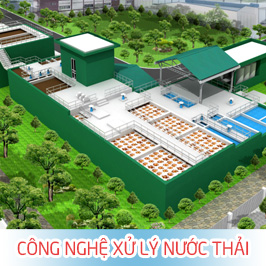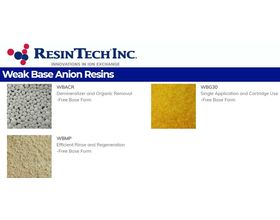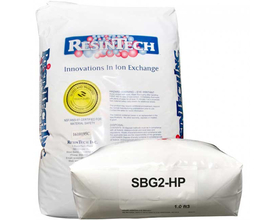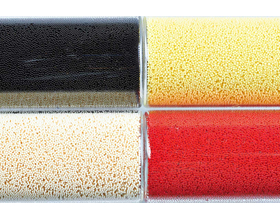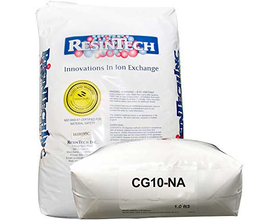Description
NHỰA TRAO ĐỔI ANION KIỀM YẾU: RESINTECH - USA
WEAK BASE ANION RESINS

Manufacturers: RESINTECH - USA
Model: WBACR, WBG30, WBMP
Tài liệu download brochue (vui lòng click link google drive dưới đây)
- Download links: Brochure tổng quan các sản phẩm RESINTECH (product summary)
- Download links: Catalogue hạt nhựa trao đổi ion RESINTECH
- Download links: Datasheet nhựa trao đổi Anion gốc kiềm yếu ResinTech _ dòng WBACR
Công ty Môi Trường Hành Trình Xanh hân hạnh là nhà nhập khẩu và phân phối chính thức Hạt nhựa trao đổi Anion kiềm yếu Resintech - USA. tại Việt Nam. Chúng tôi cam kết cung cấp sản phẩm và dịch vụ tốt nhất tới Quý Khách hàng.
ResinTech has been manufacturing a broad range of ion exchange resins for water and wastewater treatment since 1986, including cation resin, anion resin, mixed bed resin, macroporous resin, potable water grade resin, semiconductor grade resin etc. In the past four decades, we've been working with customers all over the world and have developed hundreds of resin models as per different customers and applications required, including deionization, softening, metals removal, product purification, resource recovery, pollution control, hydrometallurgy, as well as Municipal Water Treatment. Every batch of resin sold by ResinTech is fully tested and must pass a full battery of QC testing before being placed in active inventory. All ResinTech resins are manufactured to specifications that meet or exceed all published specifications for other manufacturers' equivalent products. / ResinTech đã sản xuất nhiều loại nhựa trao đổi ion để xử lý nước và nước thải kể từ năm 1986, bao gồm nhựa cation, nhựa anion, nhựa hỗn hợp, nhựa macroporous, nhựa cấp nước uống được, nhựa bán dẫn, v.v. Trong bốn thập kỷ qua, chúng tôi 'đã làm việc với các khách hàng trên toàn thế giới và đã phát triển hàng trăm mẫu nhựa theo yêu cầu của các khách hàng và ứng dụng khác nhau, bao gồm khử ion, làm mềm, loại bỏ kim loại, làm sạch sản phẩm, phục hồi tài nguyên, kiểm soát ô nhiễm, luyện kim thủy lực, cũng như Xử lý nước đô thị . Mỗi lô nhựa do ResinTech bán ra đều được kiểm tra đầy đủ và phải vượt qua kiểm tra QC đầy đủ trước khi được đưa vào kho hoạt động. Tất cả các loại nhựa ResinTech đều được sản xuất theo các thông số kỹ thuật đáp ứng hoặc vượt quá tất cả các thông số kỹ thuật đã công bố cho các sản phẩm tương đương của các nhà sản xuất khác.

1. ResinTech Ion Exchange Resins / Tổng quan về hạt nhựa trao đổi ion RESINTECH
Ion exchange resins are particularly well suited for the removal of ionic impurities for several reasons: the resins have high capacities for ions that are found in low concentrations, the resins are stable and readily regenerated, temperature effects are for the most part negligible, and the process is excellent for both large and small installations, for example, from home water softeners to huge utility installations. / Nhựa trao đổi ion đặc biệt thích hợp để loại bỏ các tạp chất ion vì một số lý do: nhựa có dung lượng cao đối với các ion được tìm thấy ở nồng độ thấp, nhựa ổn định và dễ dàng tái sinh, tác động nhiệt độ phần lớn là không đáng kể, và Quy trình này là tuyệt vời cho cả lắp đặt lớn và nhỏ, ví dụ, từ thiết bị làm mềm nước gia đình đến lắp đặt tiện ích lớn.

Tổng quan các chất ô nhiễm xử lý bằng nhựa trao đổi ion RESINTECH


2. Anion Resin / Hạt nhựa trao đổi Anion
Anion exchange resins are usually light in color. Color variation in new anion has no impact on its performance. For drinking water applications look for WQA Gold Seal or NSF certified products. / Nhựa trao đổi anion thường có màu sáng. Sự biến đổi màu sắc trong anion mới không ảnh hưởng đến hiệu suất của nó. Đối với các ứng dụng nước uống, hãy tìm kiếm các sản phẩm được chứng nhận bởi WQA Gold Seal hoặc NSF.

3. Weak Base Anion / Nhựa trao đổi Anion gốc kiềm yếu
- Weak base anions are used for reduction of organic acids and other organic materials. There are 2 types, gel and macroporous. / Các anion có tính bazơ yếu được sử dụng để khử axit hữu cơ và các chất hữu cơ khác. Có 2 loại, gel và macroporous.

- “Weak base resins do not contain exchangeable ionic sites and function as acid adsorbers. This is why the active form is referred to as the free base form. These resins are capable of sorbing strong acids with a high capacity and are readily regenerated with caustic. They are therefore particularly effective when used in combination with a strong base anion by providing an overall high operating capacity and regeneration efficiency. / “Nhựa bazơ yếu không chứa các vị trí ion có thể trao đổi và hoạt động như chất hấp phụ axit. Đây là lý do tại sao biểu mẫu hoạt động được gọi là biểu mẫu cơ sở miễn phí. Những loại nhựa này có khả năng hấp thụ axit mạnh với công suất lớn và dễ dàng tái sinh bằng xút. Do đó, chúng đặc biệt hiệu quả khi được sử dụng kết hợp với anion gốc mạnh bằng cách cung cấp công suất hoạt động tổng thể và hiệu suất tái sinh cao.

4. Anion resin in the Cl- will exchange chloride for the following: / Nhựa anion gốc Cl- sẽ trao đổi clorua cho các chất sau:
- Sulfates (SO4- -)
- Nitrates (NO3- -)
- Alkalinity (H2CO3)
- Carbonates (CO3- -)
5. In the OH form anion resin will exchange hydroxide for the following: / Nhựa anion gốc dạng OH sẽ trao đổi hydroxit cho các chất sau:
- Chloride (Cl-)
- Sulfates (SO4- -)
- Nitrates (NO3- -)
- Alkalinity (H2CO3)
- Silica (SiO2-)
- Carbon Dioxide (CO2)
6. What are ion exchange resins? / Nhựa trao đổi ion là gì?
We learn at a young age that water is made up of two atoms of hydrogen and one of oxygen. But water is much more complex than that. Contained in each drop of water are minerals and other substances that add to the chemical and physical properties of each drop—including (but not limited to) taste and smell. Some examples are calcium, magnesium, iron, manganese, sodium, hydrogen, chloride, sulfate, nitrate, hydroxide and silica. Although they are dissolved and are unable to be seen by the naked eye, these compounds exist in the water as ions. / Khi còn nhỏ, chúng ta học được rằng nước được tạo thành từ hai nguyên tử hydro và một nguyên tử oxy. Nhưng nước phức tạp hơn thế nhiều. Chứa trong mỗi giọt nước là các khoáng chất và các chất khác bổ sung vào các đặc tính hóa học và vật lý của mỗi giọt nước — bao gồm (nhưng không giới hạn) vị và mùi. Một số ví dụ là canxi, magiê, sắt, mangan, natri, hydro, clorua, sunfat, nitrat, hydroxit và silica. Mặc dù chúng được hòa tan và không thể nhìn thấy bằng mắt thường, nhưng các hợp chất này tồn tại trong nước dưới dạng ion.

The ions of these molecules have an electric charge. Ions with positive charges are called cations, while ions with negative charges are called anions. For example, sodium and hydrogen have positive charges (Na+) (H+), whereas chloride and hydroxide have negative charges (Cl-) (OH-). The electric charge dictates how ions are removed from water. / Các ion của các phân tử này có điện tích. Các ion mang điện tích dương được gọi là cation, trong khi các ion mang điện tích âm được gọi là anion. Ví dụ, natri và hydro có điện tích dương (Na +) (H +), trong khi clorua và hydroxit có điện tích âm (Cl-) (OH-). Điện tích quy định cách các ion được loại bỏ khỏi nước.
Cations (positively charged compounds) are removed with cation exchange resins, while anions (negatively charged compounds) are removed with anion exchange resins. / Cation (hợp chất tích điện dương) được loại bỏ bằng nhựa trao đổi cation, trong khi anion (hợp chất tích điện âm) được loại bỏ bằng nhựa trao đổi anion.
These ion exchange resins are composed of insoluble polymer beads designed with a "functional group" that attracts ions of the opposite charge. Each bed has many functional sites that exist all over the bead, from the surface to deep inside. / Các loại nhựa trao đổi ion này bao gồm các hạt polyme không hòa tan được thiết kế với một "nhóm chức" thu hút các ion mang điện tích trái dấu. Mỗi chiếc giường có nhiều vị trí chức năng tồn tại khắp nơi, từ bề mặt đến sâu bên trong.
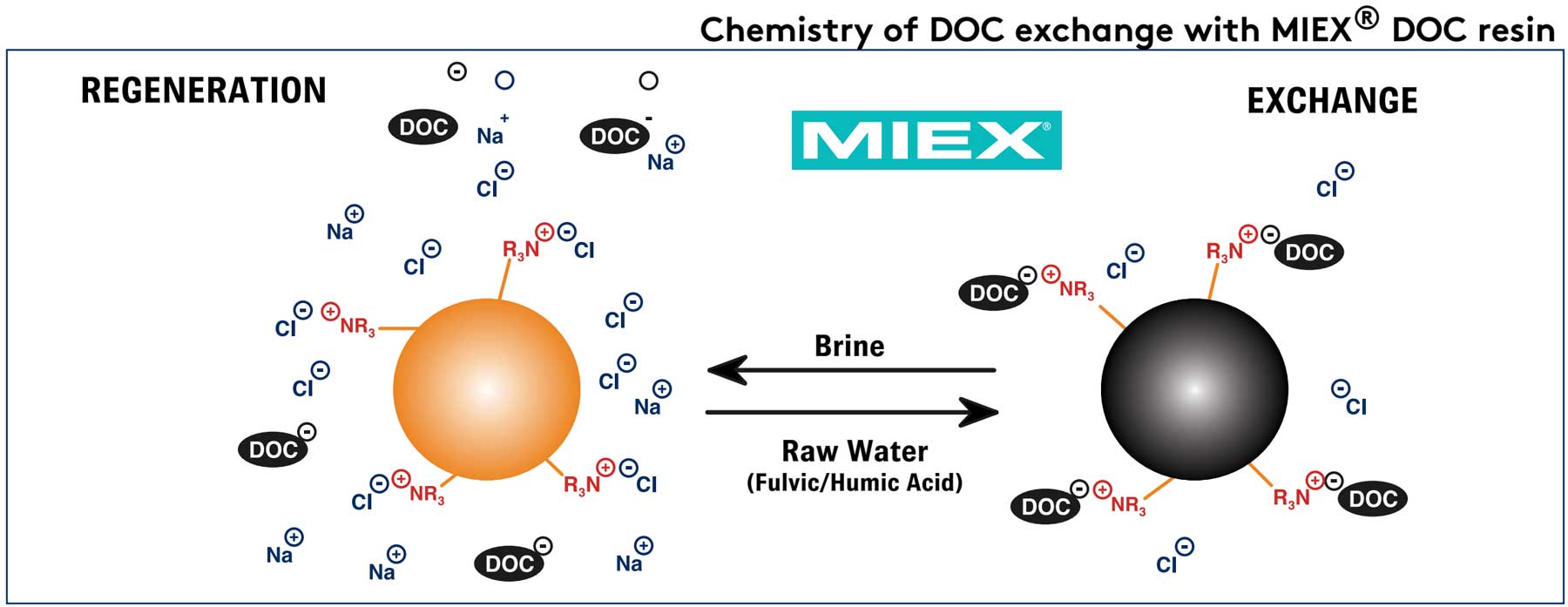
Ion exchange is a reversible chemical reaction where dissolved ions are removed from solution and replaced with other ions of the same or similar electrical charge. Not a chemical reactant in and of itself, IX resin is instead a physical medium that facilitates ion exchange reactions. The resin itself is composed of organic polymers that form a network of hydrocarbons. Throughout the polymer matrix are ion exchange sites, where so-called “functional groups” of either positively-charged ions (cations) or negatively-charged ions (anions) are affixed to the polymer network. These functional groups readily attract ions of an opposing charge. / Trao đổi ion là một phản ứng hóa học thuận nghịch trong đó các ion hòa tan bị loại bỏ khỏi dung dịch và được thay thế bằng các ion khác có cùng điện tích hoặc tương tự. Bản thân nó không phải là một chất phản ứng hóa học, nhựa IX thay vào đó là một môi trường vật lý tạo điều kiện thuận lợi cho các phản ứng trao đổi ion. Bản thân nhựa được cấu tạo từ các polyme hữu cơ tạo thành một mạng lưới các hydrocacbon. Xuyên suốt ma trận polyme là các vị trí trao đổi ion, nơi được gọi là "nhóm chức" của ion tích điện dương (cation) hoặc ion mang điện tích âm (anion) được gắn vào mạng polyme. Các nhóm chức năng này dễ dàng thu hút các ion có điện tích trái dấu.
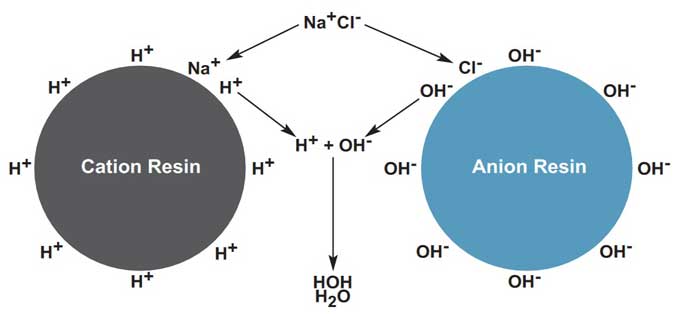
Ion exchange is used in water treatment, including water softening, industrial demineralization, condensate polishing, ultrapure water production, and wastewater treatment. It can also provide a method of separation in many nonwater processes, such as desiccation and chromatographic separation. It has special utility in chemical synthesis, manufacturing, food processing, mining, power generation, agriculture, and a variety of applications and other industries. / Trao đổi ion được sử dụng trong xử lý nước, bao gồm làm mềm nước, khử khoáng công nghiệp, đánh bóng nước ngưng, sản xuất nước siêu tinh khiết và xử lý nước thải. Nó cũng có thể cung cấp một phương pháp tách trong nhiều quy trình không dùng nước, chẳng hạn như hút ẩm và tách sắc ký. Nó có tiện ích đặc biệt trong tổng hợp hóa học, sản xuất, chế biến thực phẩm, khai thác mỏ, sản xuất điện, nông nghiệp, và một loạt các ứng dụng và các ngành công nghiệp khác.
Ion exchange resins are particularly well suited for the removal of ionic impurities for several reasons: the resins have high capacities for ions that are found in low concentrations, the resins are stable and readily regenerated, temperature effects are for the most part negligible, and the process is excellent for both large and small installations, for example, from home water softeners to huge utility installations. / Nhựa trao đổi ion đặc biệt thích hợp để loại bỏ các tạp chất ion vì một số lý do: nhựa có dung lượng cao đối với các ion được tìm thấy ở nồng độ thấp, nhựa ổn định và dễ dàng tái sinh, tác động nhiệt độ phần lớn là không đáng kể, và Quy trình này là tuyệt vời cho cả lắp đặt lớn và nhỏ, ví dụ, từ thiết bị làm mềm nước gia đình đến lắp đặt tiện ích lớn.






















